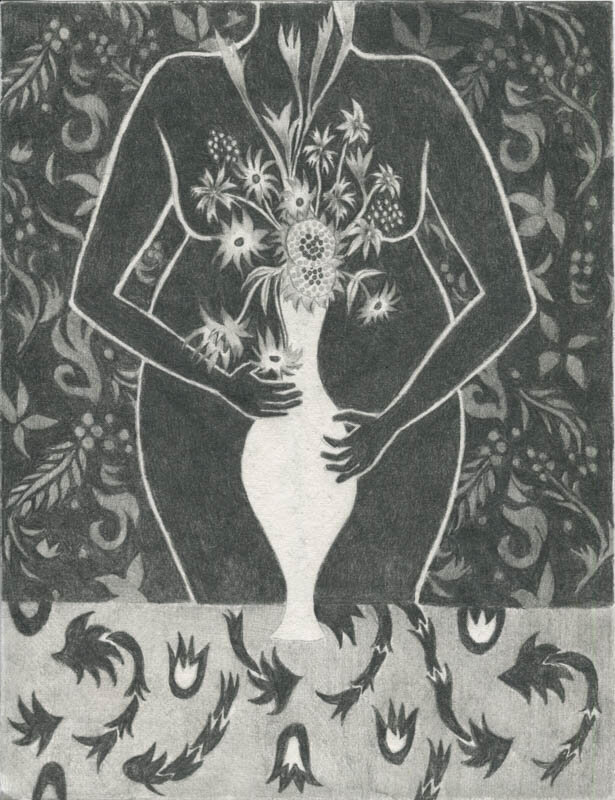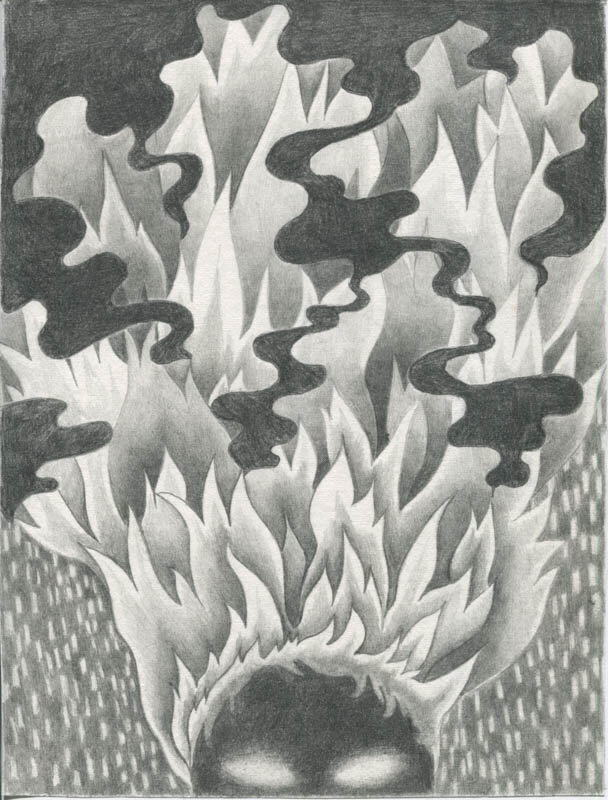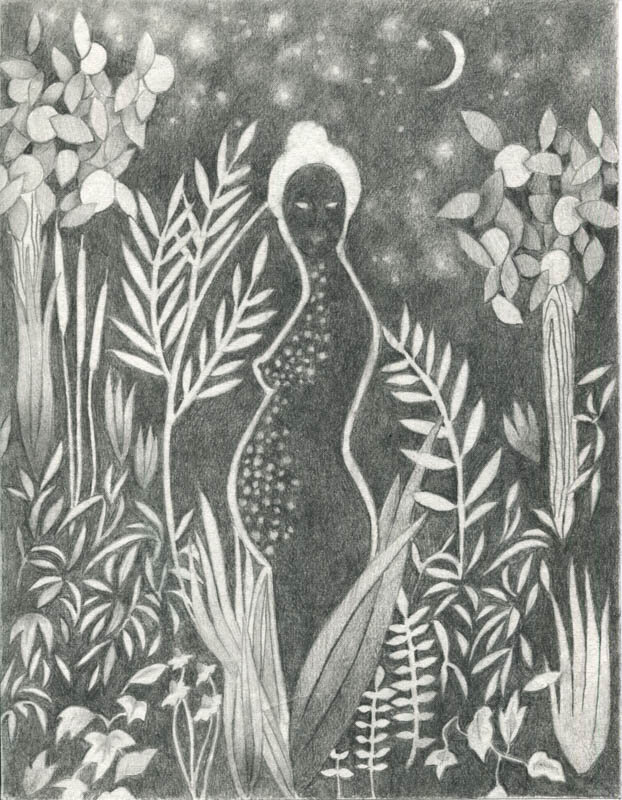Larysa Myers
I grew up in the Midwest and currently live in the small town of Beacon, New York, which I moved to nearly four years ago. Previously I lived in New York City, where I studied classical figurative and cast drawing at a traditional atelier, Grand Central Academy where I developed a love for slow, intricate and repetitive drawing techniques. I also studied textile design at FIT and these patterns and repeats show up in my work. I majored in Finance and worked in banking but left cold turkey and started working as an artist assistant while going to school part time for design at School of the Visual Arts and Fashion Institute of Technology and drawing and painting at Grand Central Academy and New York Academy of Art.
Statement
My work is like journaling, using simple materials, pencil and paper. The current restriction of my time and material due to recently becoming a mother of three has led me to simplify and direct myself. I work from imagination influenced by memory or current feelings. The repetitive action and patterns in these drawings dispels anxiety and leads me to a slow thoughtful state. My drawings are records of my own personal history as well as universal seasons and cycles of life and nature. I am interested in the ideal of motherhood with its dualities of self-denial and self-fulfillment, as well as the representation of Mother Earth and the human mother. I draw domestic scenes and wild natural scenes, describing different parts of an identity.
It's Winter, 2018. Graphite on Japanese Paper, 8.5 x 11 inches
Interview with Larysa Myers
Questions by Emily Burns
You previously studied finance, but in your words you quit 'cold turkey’ and began to study art and textile design in NYC. Can you tell us that story? Were you always a creative person, but decided to try a different path, or did following a creative direction come later?
I always was drawn to art but had no idea there was such a thing as a creative life until I moved to New York City. I grew up in a suburb outside of Chicago and it felt very homogenous and planned and corporate. I never met anyone that did anything artistic.
In college I majored in Finance and tried to fit in the best I could in a pretty stressful banking job and had a ton of drive and motivation. But I couldn’t get interested in the work and it didn’t come naturally to me. I moved to New York because I wanted to learn more about art. I was always painting in my room and taking classes. Eventually I realized I really needed to make a change and I quit without any practical plans and pursued art.
You currently work primarily in graphite on paper. When did you begin working with this medium and what drew you to it?
I studied cast and figure drawing at the Grand Central Academy of Art after leaving finance in 2008. We drew one cast every night for three hours for a month and filled in every dot, every gradient had to be perfect. It was really painstaking and painful at first but I learned to enjoy the slowness of it and learned to draw in the classical style.
What is the process of making a drawing like for you?
Sometimes an image will come to my mind. Other times I’ll have a feeling I’ll try to render. Sometimes an idea doesn’t make much sense and there’s a lot of back and forth in the drawing and when I’m in it I realize why I wanted to do it.
I draw from imagination and make some sketches. I use source material pulled from the internet or other artworks. I’ll sketch out a few different ideas to see what resonates with me. Then I’ll make an outline and transfer it to the final paper then will work on the gradients and pattern work and final details.
Is there a particular graphite or paper that works best for what you are trying to achieve?
I really like Japanese paper and Staedtler mechanical pencils.
Is there a benefit in terms of limiting the medium, color, and more when working?
Yes I think there is because it forces me to figure out the image.
You studied figurative art at Grand Central Academy. I have also studied there! Its an incredible school. What drew you to studying process with that intensity, and do you still incorporate that knowledge in your practice? Your work is figurative but also loose and gestural, whereas I think of GCA techniques as being more tight, highly representational and naturalistic.
That’s so cool! I do not meet many people now that have gone there. I think I am drawn to really disciplined studies. I love the visual affect of classical paintings and drawings. The style also gave me a pathway after leaving finance, it was methodical and sort of analytical, like my past life. The slowness was frustrating but looking back it made me ok with taking a long time on things and slowing down.
My drawings now are my own interpretation of the classical figures I studied. I use the classical technique but on my own forms. I was always drawn to the figure and studied also at New York Academy of Art. GCA offered an intensive night program that mirrored their day program and I thought I would get a lot out of it. I do have a place in my heart for academic work and the Hudson Valley Painters, and especially academic drawings, like those of Pierre Paul Prud’hon.
Does your past study of textile design factor into your work? Do you do any design these days?
Yes it definitely does. I love to figure out pattern, what would make it interesting. It feels like music or notes and also offers reassurance with the repetition and how it can fill the page. I don’t design now but just use the pattern work in my drawings. That way I can make whatever patterns I want.
Your subject matter often includes figures and nature—can you talk about this combination in your work?
Being upstate allowed me to connect more to the cycles of nature, the atmosphere, the moods of the seasons. It mirrors the cycles of our lives. The figure in different environments represents different parts of the psyche, different emotional states. I’m interested in symbols of transformation, fertility and time, which can be found in nature. Nature was a very immersive experience for me when I moved upstate.
How is your relationship with motherhood related to the plants and mother earth imagery in your drawings?
I play with the ideas of mother and woman in general from the past and present imagery and combine it with my own experience. Woman has been creator and nurturer, fully supporting the continuation of life, and also a vessel, existing only to provide. Some drawings are about abundance and fertility and others drought and deluge. Earth can also be thought of as the primary womb.
Rebirth, 2019. Graphite on Japanese Paper, 8.5 x 11 inches
What is a typical day like for you?
I recently had three children in two years so at this point nearly all of my day is devoted to them. I draw at night once every one is asleep. I will have more time to work as they grow older but it has forced me to be really productive with what time I have now.
You live in Beacon, a small town in upstate New York, after living in NYC for 7 years. What prompted the move? What is the town of Beacon like for artists?
I have really thrived being away from the city. In NYC I was too overstimulated and it didn’t seem sustainable. I craved being in nature and felt on edge.
Beacon is a friendly town, it mirrors the warmth of the Midwest. It’s small and supportive and convenient. Everything seems accessible—the mountain and the river are both about a 20 minute walk from me, in opposite directions with Main Street in between. A few new galleries, Mother and Parts and Labor have opened up within walking distance of Dia Beacon. There are good shows to see but it is not overwhelming. It is only a little over an hour from the city if you want to go back. It’s also close to Newburgh, Kingston, Catskill and Hudson areas where artists are also working. It’s a great jumping off point for all the Hudson Valley has to offer. It seems like a great spot to be.
Can you tell us about your studio? What do you need to be productive in the studio?
My studio is at home and is quite pared down at the moment. To be productive I really need to relax enough and get out of my day to day thoughts.
Larysa in her studio in Beacon, NY
Do you prefer to be energetic and upbeat or calm and reflective when working?
More calm and reflective but hopefully excited.
How do you cultivate the mood in the studio?
I think it comes after I’m alone for some time. Music and looking at images or parts of movies can help.
What is one of the most exciting or interesting exhibitions you have seen recently?
I loved Roger Brown at Museum of Arts and Design.
Who are some of the artists you look at most often?
It always varies, but consistently: Boticelli, Sue Ellen Rocca, Roger Brown, Paula Modersohn-Becker, Frida Kahlo, Rousseau, Ingres, Charles Burchfield, Gertrude Abercrombie, the Weiner Werkstatte, Indian Miniature Painting and Biblical imagery. Some of the artists I like that are working right now are Julie Curtiss, Emily Mae Smith, Sarah Peters, Scott Kahn, Louise Despont and Penny Davenport.
Is there any advice you have received that you remember often?
There is a saying in Ashtanga Yoga which I practice, it’s “99% practice, 1% theory,” which always stays with me.
Whats up next for you?
I want to draw more and experiment with oils paint again. I will also have a drawing at Mezzo in the Lower East Side in December and January.
Thanks so much for taking the time to talk with us!
Thank you!
To find out more about Larysa and her work, check out her Instagram.







